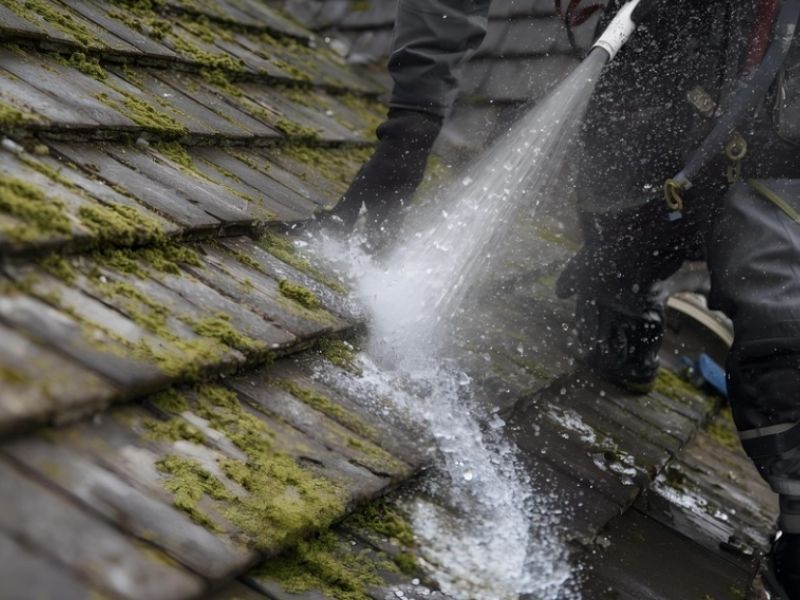
Slate roofs add character and value to any property. These natural stone tiles can last 75 to 100 years or more when properly maintained, making them one of the most durable roofing materials available. However, many property owners make critical mistakes when attempting to clean their slate roofs, potentially reducing the lifespan by up to 30% through improper methods.
We see countless cases where well-intentioned cleaning attempts cause more harm than good. Whether you own a domestic property with a beautiful slate roof or manage commercial buildings, understanding what to avoid can save you thousands in costly repairs.
Slate roof tiles differ significantly from other roofing material types. The natural stone has a delicate surface that responds poorly to aggressive cleaning methods. Unlike concrete roof tiles or clay tiles that can withstand more robust treatment, slate demands a gentler approach.
The surface of slate tiles naturally sheds water when intact. Once this protective layer gets damaged, the material becomes porous and vulnerable to moisture penetration. This explains why pressure washing and similar aggressive techniques prove so destructive.
High pressure washing ranks among the worst cleaning methods for slate roofs. A pressure washer delivers water at forces that erode the natural surface of the stone. What seems like an efficient way to blast away moss and debris actually strips away the protective layer that has kept your roof intact for decades.
Professional observations show that roofs subjected to high pressure washing often need slate tile replacements within just a few years. Even a single misplaced step can cost £20 to £40 per tile to replace, and pressure washing damage frequently affects multiple tiles across the whole roof.
The water penetrates small cracks made worse by the force, leading to problems during freeze-thaw cycles. When trapped moisture expands in cold weather, it causes the slate to crack and split. These issues multiply quickly, turning what started as a cleaning project into an expensive repair job.
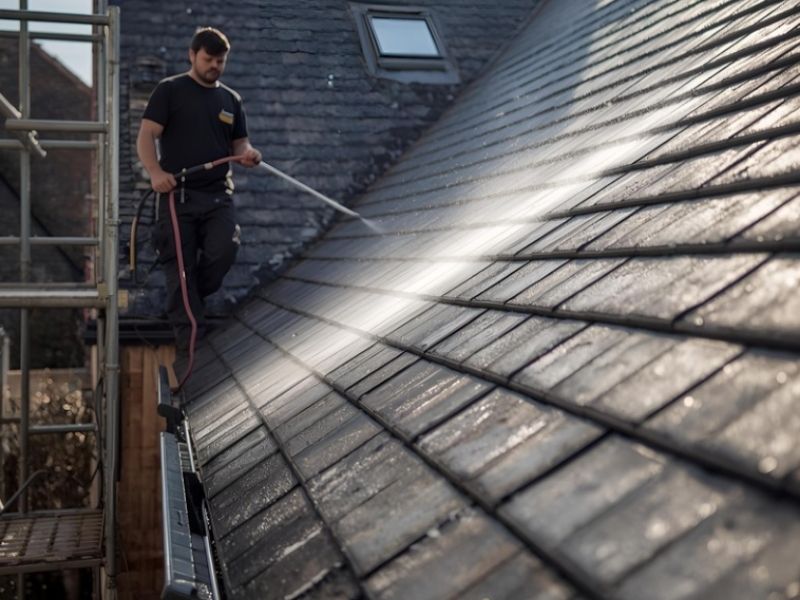
Many people underestimate how fragile slate roof slates can be under foot traffic. The tiles are strong when properly supported, but direct weight from walking creates stress points that easily cause cracks.
Professionals use roof ladders specifically designed to distribute weight across multiple tiles. These tools spread the load and prevent the concentrated pressure that leads to breakage. Without this equipment, each step risks damaging tiles that have survived decades of weather.
The cost adds up quickly. Broken tiles need immediate replacement to prevent water ingress, and finding matching slate for older roofs often proves difficult and expensive. Prevention costs far less than cure when it comes to maintaining slate roofing material.
Harsh wire brushes scratch the smooth surface of slate tiles, creating tiny grooves where moss and algae can attach more easily. Research shows that roofs cleaned with abrasive tools often see organic growth return in as little as 12 months, compared to several years for properly cleaned surfaces.
The scratches also compromise the water-shedding properties of the slate. Rough surfaces trap moisture, accelerating deterioration and providing ideal conditions for future moss growth. What seems like thorough cleaning actually makes the problem worse over time.
Gentle brushes made from softer materials work better when manual cleaning becomes necessary. These tools remove debris without damaging the underlying stone, preserving the natural surface that protects against moisture and weathering.
Not all cleaning solutions are safe for slate roofs. Harsh chemicals, particularly those containing high concentrations of acid or bleach, can permanently discolour the natural stone and corrode the metal fixings that hold tiles in place.
Acidic cleaners react with the minerals in slate, causing etching and colour changes. These products might remove moss effectively in the short term, but the damage to the roof structure outweighs any cleaning benefits. Corroded nails and hooks loosen over time, increasing the risk of loose tiles and potential leaks.
Some commercial cleaning products marketed for general roof cleaning contain ingredients unsuitable for delicate roofs like slate. Always check product specifications before applying any cleaning solution to slate surfaces. Better yet, rely on natural products or specialist treatments designed specifically for this material.
Steam cleaning can work safely on slate when done correctly, but improper technique causes problems. The high heat needs careful control to avoid thermal shock, which can crack the tiles. Temperature changes must happen gradually to prevent damage. For those comparing roof steam cleaning versus scraping method, it’s important to weigh the benefits of heat-based cleaning against the precision of manual removal.
Steam cleaning should always be combined with appropriate safety measures. The heat loosens moss and organic growth effectively, but operators need experience to keep temperatures within safe ranges. This method works best in professional hands rather than as a DIY approach.
When executed properly, steam cleaning ranks among the safest methods for slate roof cleaning. The key lies in understanding the limitations and respecting the material. Rushing the job or using excessive heat negates the benefits this technique can offer.
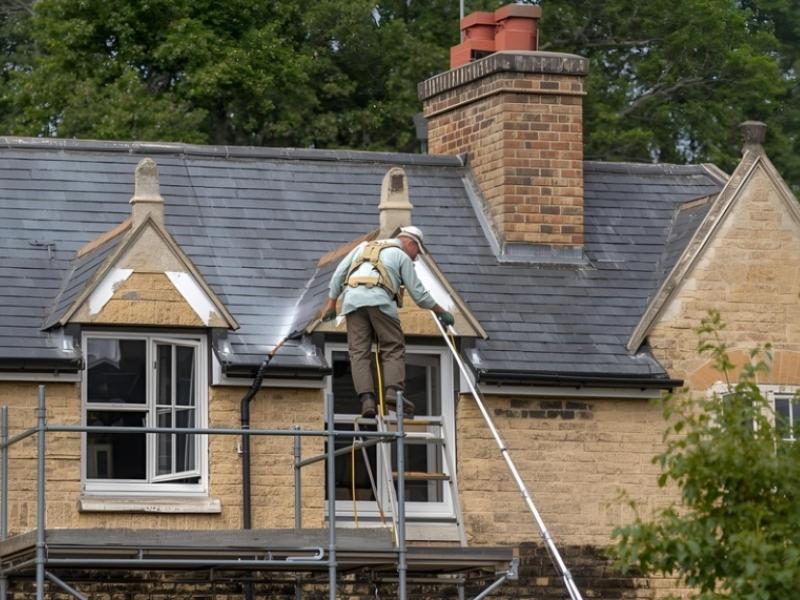
Biocide treatment plays an important role in preventing future moss growth when applied correctly. These treatments can keep slate roofs moss-free for 4 to 6 years after application. However, incorrect application wastes money and potentially harms the roof.
Applying biocide without first removing existing moss proves ineffective. The treatment needs direct contact with the clean roof surface to create a protective barrier. Similarly, using too much product does not improve results and may leave residue that affects the roof's appearance.
Timing matters too. Applying treatment just before heavy rain washes it away before it can bond with the surface. Weather conditions need consideration for optimal results. Professional cleaning companies understand these factors and schedule treatments appropriately.
The statistics tell a clear story. Professional roof cleaning is strongly recommended for slate, as DIY attempts are linked to a higher rate of accidental breakage compared to other roof types. Homeowners lacking proper equipment, experience, and safety training face significant risks.
Safety equipment represents a major concern. Working at height requires specific training and personal protective equipment. Falls from roofs cause serious injuries every year, many occurring during cleaning attempts. Non slip footwear, harnesses, and proper ladder positioning are not optional extras.
The job also demands knowledge about slate characteristics and cleaning methods. What works on concrete tiles or asphalt shingles can destroy slate. Without this expertise, property owners often discover their mistakes only after causing irreversible damage.
Several cleaning mistakes lead to trapped moisture in slate roofing systems. Damaged tiles that do not sit flush against each other create gaps where water accumulates. This moisture has nowhere to go, particularly when gutters become blocked or damaged during cleaning attempts.
Broken or cracked tiles need immediate attention. Left untreated, they allow water to reach the underlying structure, potentially causing rot in timber supports. The damage spreads outward from these initial points, requiring increasingly extensive repairs as time passes.
Some cleaning methods inadvertently create conditions for moisture retention. For example, removing all moss but leaving debris in gutters means water cannot drain properly. Taking a comprehensive approach to roof maintenance prevents these interconnected problems.
Cleaning slate roofs without first conducting a thorough inspection leads to missed problems. Professionals always inspect and assess the roof condition before beginning work. This evaluation identifies damaged tiles, weak areas, and potential hazards.
The inspection reveals whether cleaning is even appropriate. Severely deteriorated roofs might need repairs before any cleaning takes place. Attempting to clean a structurally compromised roof can cause catastrophic failures, leading to injuries and major property damage.
This assessment also informs the cleaning approach. Different levels of moss coverage and different slate types require adjusted techniques. A one-size-fits-all approach ignores these variations and increases the likelihood of damage.
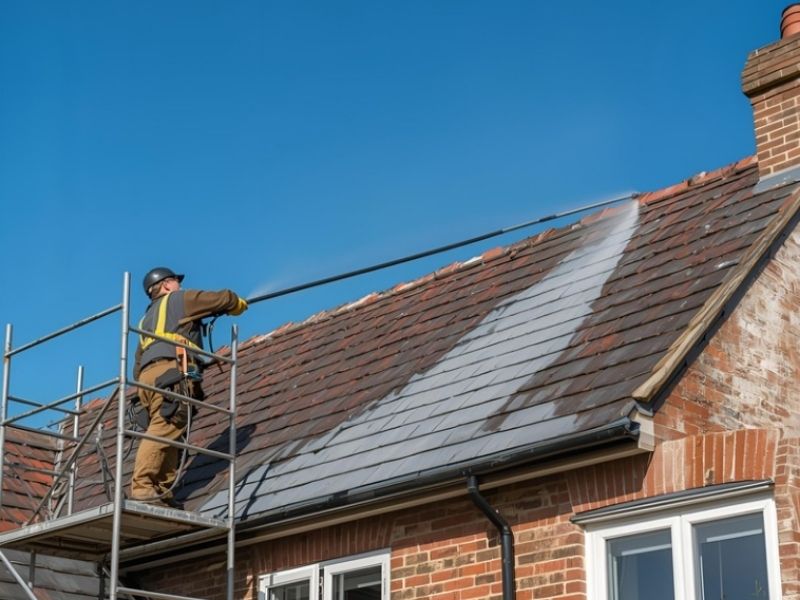
Improper cleaning can loosen the nails or hooks that hold slate in place, increasing the risk of leaks and even roof collapse in extreme cases. These fixings often remain hidden until problems become obvious, by which time significant damage has occurred.
Water ingress from damaged or displaced tiles causes multiple problems. Insulation loses effectiveness when wet, increasing energy costs. Timber structures rot when exposed to persistent moisture. Ceilings show staining and potentially develop mould, creating health concerns for occupants.
Structural integrity depends on maintaining the complete roof system. Every component plays a role, from individual tiles to the fixings, underlayment, and support structure. Cleaning methods that compromise any part of this system put the whole roof at risk.
Metal fixings corrode over time, particularly when exposed to harsh cleaning chemicals or when moisture penetrates through damaged tiles. These deteriorated fixings fail to hold slate securely, creating dangerous conditions where tiles can slip or fall.
Replacing fixings often requires removing and reinstalling multiple tiles around the affected area. This work becomes complex and expensive, especially on older roofs where finding matching materials proves difficult. Prevention through proper cleaning methods costs far less than these repairs.
Regular maintenance includes checking for loose or damaged tiles, but aggressive cleaning can create dozens of these problems simultaneously. The cumulative effect turns a manageable maintenance task into a major restoration project.
Soft washing has emerged as one of the safest methods for cleaning slate roofs. This technique uses low pressure water combined with specialist cleaning solutions that break down organic matter without damaging the tile surface. For homeowners asking what is soft wash roof cleaning, it’s essentially this gentle approach that prioritizes preservation over force.
The process works gradually rather than blasting away growth with force. Solutions applied to the roof have time to penetrate moss and algae, loosening their grip on the slate. Gentle rinsing then removes the debris without putting stress on the tiles or fixings.
Professional roof cleaning services have adopted soft washing widely because it protects the roof while delivering results. The method extends the lifespan of slate roofs by removing harmful organic growth without causing the damage associated with high pressure washing.
Manual scraping has a place in slate roof maintenance when done correctly. Gentle tools combined with careful technique can remove stubborn moss without scratching or damaging the underlying surface. This approach takes more time than pressure washing but preserves the roof's integrity. For many homeowners wondering what type of roof cleaning is best, this careful method often provides the right balance between effectiveness and preservation.
The key lies in using appropriate tools and knowing when to stop. Aggressive scraping crosses the line into damage quickly. Experienced professionals understand the difference between removing moss and abrading the slate surface.
Combining manual cleaning with biocide treatment provides long-lasting protection. The treatment prevents regrowth, meaning the roof stays clean for years rather than months. This combination offers excellent value compared to frequent aggressive cleaning cycles that damage the roof over time.
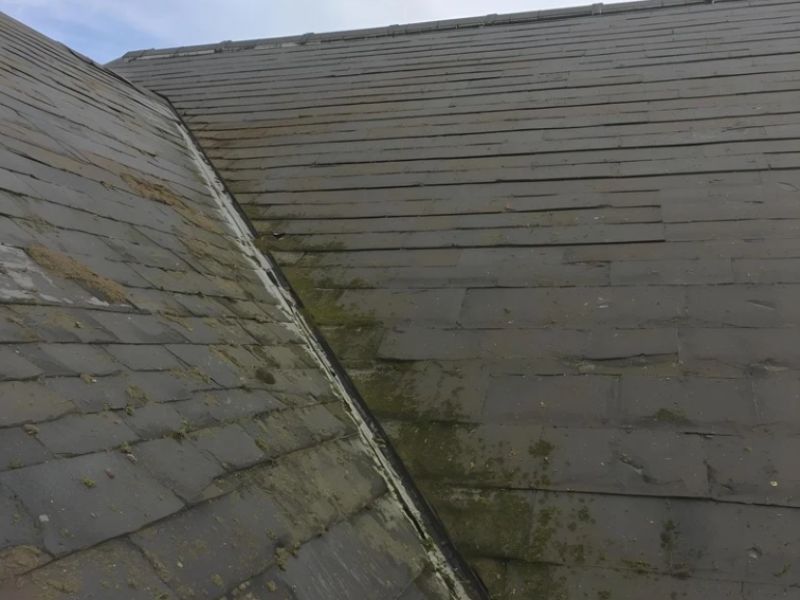
Property owners face many decisions about slate roof maintenance. The information provided here helps you understand what to avoid, but knowing what not to do is only part of the solution. Professional cleaning services bring the equipment, expertise, and safety measures needed to clean slate roofs properly.
We work on both domestic and commercial properties across Newcastle and the surrounding areas. Our team uses soft washing and other approved techniques that protect your valuable slate roofing material while removing moss, algae, and dirt effectively.
Slate roofs represent a significant investment in your property. Protecting that investment means choosing cleaning methods carefully and trusting experienced professionals who understand this unique material. Contact Roof Cleaning Newcastle today for a free quote on slate roof cleaning services that extend the life of your roof without risking damage.